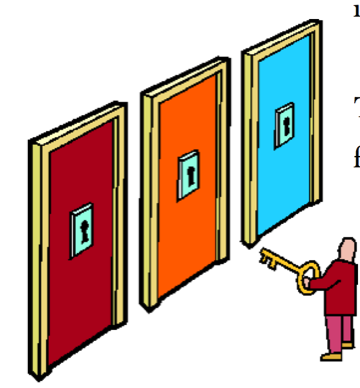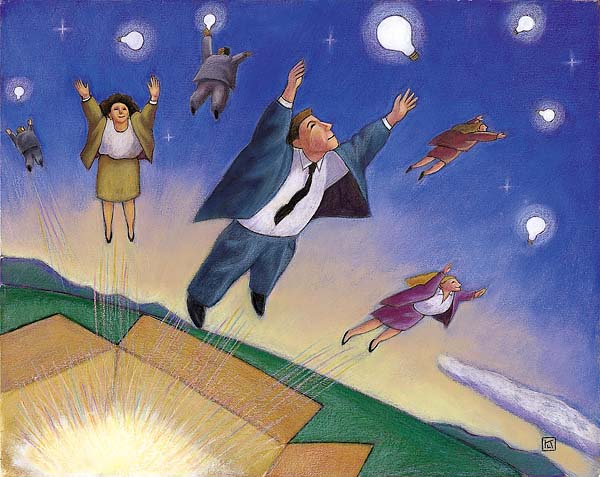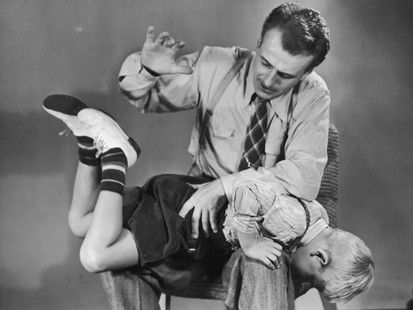The 50 Proposed Maxims of neuroELT
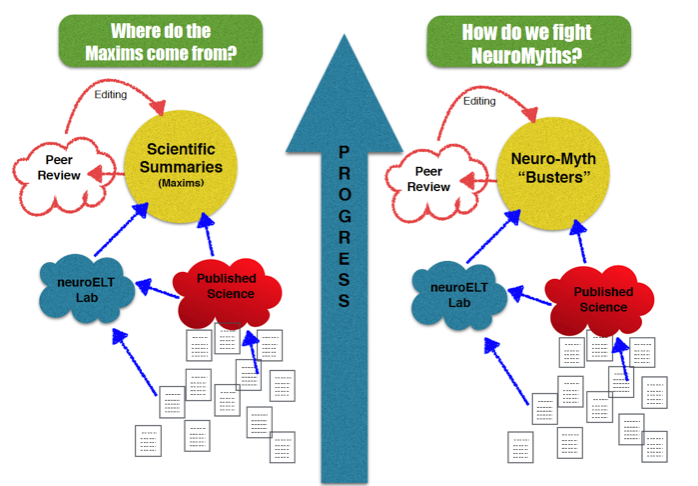
22. No "bias", no learning.
Bias gets a negative rap. But scientific bias is simply about tendencies -for neuroELT it is about preferred neuro-patterns that our brains have. Learning is proof of bias; bias is proof of learning. Another important type of bias is Positive Bias. Due to Darwinian Logic (natural selection), humans tend to have a Positive Bias; positive bias keeps the human race alive. (The human"ancestors" that were not positive and were depressed most of the time probably had less productive lives, and probably left less children to pass on their depression to. So, via natural selection, the human race shows a positive bias.) It gets us up in the morning. Bias is at the core of motivation. Bias is at the root of culture, too, because bias is about our tendencies and habits.
In neuroscientific terms, bias is the tendency to use "neural network A over neural network B", forcing Long Term Potentiation (LTP) and more myelination on network A. This, in turn, makes network A more efficient, and even more bias occurs because of the higher level of efficiency. From network A's perspective, this is like a virtuous cycle; more usage makes it more efficient which brings on more usage, which makes it even more efficient...
Q. What does this maxim mean? Explain in your own words.
23. "Solvable mysteries" are central to all natural learning processes.
Provide solvable learning challenges at many steps during the learning process. They must be solvable mysteries-- not too hard, not too easy. In short, don't TELL your students an answer when you can find a way for them to figure it out themselves. Why is this important? The brain's reward system (primarily the nucleus accumbens) provides dopamine and other pleasurable chemicals to our bodies when we solve a problem, or "mystery" (Storm & Tecott, 2005). The mystery solving process evokes creativity and therefore nurtures strategic networks for the purpose of solving those mysteries. If a teacher simply blurts out the answer, the teacher robs the student from developing more intelligent strategic networks AND robs them of the dopamine rush that they would have attained had they been given the opportunity to solve it themselves. Also, the pleasure system can trump stress and helps keeps students aligned. Negative stress kills learning. Chaos keeps students in developmental purgatory. Therefore, solvable mysteries (pleasure evoking learning tasks that nurture strategic networks in the brain) should be the core component in any teacher's bag of tricks.
Q. Were you ever hooked on mysteries? Perhaps a mystery based computer game? How can you bring that unique 'hook' into your classroom?
24. "Performances" of Understanding are essential for good assessment.
How can we make learning and understanding visible? How can we assess learning and understanding if it is not made visible? As teachers, we must realize that while we cannot watch the learning networks fire up in the brain in realtime (unless we have the apparatus for it in our classrooms!), we can do the next best thing. We can get our students to demonstrate their understanding of the concepts. This is called a Performance of Understanding (PoU). A PoU is not a simplistic test, it is an opportunity given to students to synthesize their learning and take it to the next level in the form of a realtime performance. An example of an effective PoU is the ability to conduct an interactive presentation on the subject covered. A PoU is not only more fair than the average paper-based test, it also allows students to follow their passions, keeps them more motivated, and inspires further learning.
Q.What would be a good PoU for a unit of study that you are currently teaching?
25. "Assess" in three ways.
This is the Trinity of Assessment: (1) Self-Assessment, (2), Peer-to-peer Assessment, and (3) Teacher-student Assessment. Most teachers employ at least one of these assessment styles, but rarely are all three employed within a single module of learning. Why is the Trinity of Assessment so important? Self-Assessment forces students to self-reflect; it causes meta-cognition to happen. Although some students may be conscious of their actions, not all students actually do this, and certainly not all do it in a uniform or predictable way. Simply allowing students to rate their work on a 1-5 scale after each completed section will do wonders for motivation and alignment. The next step is to also allow for peer-to-peer assessment. When students are given time for a PoU (Performance of Understanding), other students should have self-designed criteria to assess the performances. With each successive PoU, students learn to want to do better at designing assessment criteria and with their own performances. With all this good assessment going on (while teachers seem more like facilitators), it may seem that teacher assessment may not even been needed. Indeed, in some cases, teacher assessment can be minimalized -- but should not entirely dismissed. Students still need the occasional scoring from the teacher to keep them aligned and build confidence that they are on the right path. A little bit of advice from teachers can go a long way.
Q. Which of the trinity do you most often implement in your classrooms?
Why is that? Think of ways to implement the trinity!
26. "Comforting" solutions are the chosen solutions, even if they are false.
False reasoning can still provide massive satisfaction for the body. The human brain craves solutions and reasons. Much of what makes us human (higher cognition) in the brain is dedicated to seeking out reasons. We give ourselves dopamine for coming to reasons/solutions during aha moments even if we are wrong in the grander scale; we take pleasure from the dopamine and it give us positive feelings (Salamone & Correa, 2002) even if we are wrong. Therefore, universal validity is not important for solo satisfaction. This goes far in explaining naive human psychology even in adults who should know better (incongruent actions, and unsubstantiated faith). It also works against education at times, for obvious reasons -- students can be totally satisfied and ecstatic even when arriving at wrong solutions and reasoning patterns. Teachers and students must learn how to see through this phenomenon. In short, the dopamine providing solution is often the "chosen solution" in spite of the bigger picture's reality.
Q. Is this a concept that you would like your students to understand? How would you teach them this?
27. "Needs" are unknown; stay flexible.
What are your students' needs? What do they desire? What do you desire from them? When given the chance, the human frontal cortex will provide synthesis and responses for just about any question, even if it is not qualified to provide an answer. This is also satisfying (see above). What this means is, just because your brain provides an answer to a question such as "What are your needs?", it does not mean that those are your actual needs. (For example, how do they differ from your 'wants'?) Positive bias and our inevitable human conceit keep us from realizing that our responses to questions, even if they are personal, are not always correct. For alignment purposes, implementation of "needs analysis" (needs of the teacher, student, school, etc.) is essential, but it must be understood that (1) students' brains don't always provide them with the correct answer, and (2) students are bad at predicting how their bodies will react to what they will be learning in the future, so wants and needs tend to blur, too. So, while alignment via needs analysis is essential, staying flexible enough to avoid disappointment and loss of motivation is equally, if not more important.
Q. Have you ever done a needs analysis? If so, what do you think about needs analysis now?
28. "Rigidity" produces dissonance, the root of stress.
As can be seen from the above two maxims, for the body, being wrong can be just as comforting as being right. In fact, the body does not care about what is 'universally' right or wrong. It is primarily focused on feeling good right now. Your frontal cortex may talk you out of missing a boring meeting, but if the rest of your body had its own way, you would not be attending that boring meeting -- you'd be doing something more immediately pleasurable and satisfying for your body. Being at the boring meeting will be a cause of stress for you, and it was your own rigidity that brought on that stress. Other animals don't regularly cooks themselves with stress and pressure. In this way, human adherence to our own cultures creates stress for ourselves in a uniquely human manner. Current psychology and neuroscience both tell us that we seem to be creating too much stress for ourselves. We stay in the rut. However, knowing about this may help teachers and students better deal with stress, and may help foster less stressful cultures in the future.
Q. Do you know rigid people? How do they make you feel? Relate this to classroom teaching.
29. "Varying" helps recall.
Novelty and happy surprise are very emotional for the body. Not only will positive surprise keep students awake in class, it will help foster alignment and naturally make the lesson more memorable (Wang et al., 2005). Small changes to the regular schedule can be enough to keep students on their toes, but medium surprises such as changing seating patterns and big surprises such as guest speakers or sudden field trips can promote attentive focus and foster lasting impressions (Raz & Buhle, 2006). Give opportunities to students to surprise the teacher as well. As in the maxim above, variety and positive surprise helps deliver students and teachers from potential ruts and fosters a more positive social atmosphere. Looking for serendipity while teaching is perhaps the best way to sum up this maxim.
Q. What can you do to add more variety to your current lessons?
30. "Creativity" delivers us from ruts.
Creativity is necessary to break away from cultural molds that bind students to conservative one-way thinking. It is literally liberated thinking. Students who are scared to make mistakes and be creative generally have an active (sometimes enlarged) amygdala. This keeps them conservative in their ways, or, in a rut. The amygdala is the alarm in humans and other animals that excites our bodies when we are in danger. When it is engaged too frequently it causes trauma such as war veterans with PTSD (Post-Traumatic Stress Disorder). Even in normal usage, the amygdala sparks adrenaline production which is good for the "fight or flight" reactions, but it physically restricts peripheral vision and peripheral thinking. We actually lose our peripheral vision when our amygdala fires hot. It does this because in a fight, what we need is a sharp focus on our enemy and animalistic skills to achieve a simple and direct victory. In short, the amygdala and it's related systems impede creative thinking and make us more physical, or animalistic (Pawlak et al., 2003; Willis, 2010). Have your ever encountered a student angrily shouting out in the classroom unreasonably at you or a peer, seemingly without any concern about his/her other peers? If so, it is likely that whatever caused the rage triggered his/her loss of peripheral vision. The student would then be solely fixated on the cause of the anger and would not capable of understanding outside input, especially from you, if you were at the root of it. It takes time for such students to calm down and gain their peripheral vision back. No academic learning can happen this entire period of time -- at this stage we are only there for 'fight or flight'; our academic minds are turned off. It is an intriguing phenomenon that may have done magic for us in the jungle, but it creates interesting problems for us living in the more sophisticated societies of today.
Due to biological differences AND immediate context, there will always be a spectrum spanning from conservative to liberal within groups of people. Studies show that when we perceive negative input, we tend to send the message to the lower areas of the brain for speedy animalistic processing, and when we perceive positive input, we send the message to our frontal cortex for slower but higher level assessment (Pawlak et al., 2003; Willis, 2010). As we can see from this bio-sociological phenomenon, there are biological and sociological reasons for the conservative-liberal dichotomy. From the discussion within this maxim we can deduce why liberal people tend to be more creative and outgoing while conservative people tend to be more protective of themselves and less pioneer spirited. Politics aside, creativity and liberal thinking is generally a good thing in the classroom -- we want students to use higher level thinking, right? It is literally more mind expanding. The first steps toward creativity in the classroom is relaxation and the loss of potential inhibitions and anxieties. Students can get hooked on creativity if the are in conducive contexts, and their own reward systems get to kick in when they realize creativity. However, anger and stress will easily diminish these achievements and put students back in to ruts.
Why then does over-the-top military training work for the military? Why do schools that implement punishment-centered militaristic training claim success? Consider the biological phenomena discussed. When being shouted at at boot camp, with an adrenaline rush in you and within your superior officer, you cannot fight nor fly from the situation. Your peripheral vision is gone. You must bare it. You must be a robot and follow the rules perfectly -- or else dire consequences await you. So you obey. You are so wired up that you can't think liberally; you do not have higher level thinking. If you think liberally, you will die, or someone will die, they tell you. In this way, you are kept aligned and kept from thinking outside of the box. This is good for the military. If the goal of the school or training is to create rigid robotic soldiers (or workers), then this type of training is actually ideal. However, the huge tradeoff is: Deep Understanding is not the goal, therefore only simplistic learning is accomplished. In a nutshell, this type of training is good for producing pawns of war or pawns of labor, but it is not good for producing creative management.
Q. What is creativity? How can you embrace and encourage creativity in your classrooms? Why would that be important?
Bias gets a negative rap. But scientific bias is simply about tendencies -for neuroELT it is about preferred neuro-patterns that our brains have. Learning is proof of bias; bias is proof of learning. Another important type of bias is Positive Bias. Due to Darwinian Logic (natural selection), humans tend to have a Positive Bias; positive bias keeps the human race alive. (The human"ancestors" that were not positive and were depressed most of the time probably had less productive lives, and probably left less children to pass on their depression to. So, via natural selection, the human race shows a positive bias.) It gets us up in the morning. Bias is at the core of motivation. Bias is at the root of culture, too, because bias is about our tendencies and habits.
In neuroscientific terms, bias is the tendency to use "neural network A over neural network B", forcing Long Term Potentiation (LTP) and more myelination on network A. This, in turn, makes network A more efficient, and even more bias occurs because of the higher level of efficiency. From network A's perspective, this is like a virtuous cycle; more usage makes it more efficient which brings on more usage, which makes it even more efficient...
Q. What does this maxim mean? Explain in your own words.
23. "Solvable mysteries" are central to all natural learning processes.
Provide solvable learning challenges at many steps during the learning process. They must be solvable mysteries-- not too hard, not too easy. In short, don't TELL your students an answer when you can find a way for them to figure it out themselves. Why is this important? The brain's reward system (primarily the nucleus accumbens) provides dopamine and other pleasurable chemicals to our bodies when we solve a problem, or "mystery" (Storm & Tecott, 2005). The mystery solving process evokes creativity and therefore nurtures strategic networks for the purpose of solving those mysteries. If a teacher simply blurts out the answer, the teacher robs the student from developing more intelligent strategic networks AND robs them of the dopamine rush that they would have attained had they been given the opportunity to solve it themselves. Also, the pleasure system can trump stress and helps keeps students aligned. Negative stress kills learning. Chaos keeps students in developmental purgatory. Therefore, solvable mysteries (pleasure evoking learning tasks that nurture strategic networks in the brain) should be the core component in any teacher's bag of tricks.
Q. Were you ever hooked on mysteries? Perhaps a mystery based computer game? How can you bring that unique 'hook' into your classroom?
24. "Performances" of Understanding are essential for good assessment.
How can we make learning and understanding visible? How can we assess learning and understanding if it is not made visible? As teachers, we must realize that while we cannot watch the learning networks fire up in the brain in realtime (unless we have the apparatus for it in our classrooms!), we can do the next best thing. We can get our students to demonstrate their understanding of the concepts. This is called a Performance of Understanding (PoU). A PoU is not a simplistic test, it is an opportunity given to students to synthesize their learning and take it to the next level in the form of a realtime performance. An example of an effective PoU is the ability to conduct an interactive presentation on the subject covered. A PoU is not only more fair than the average paper-based test, it also allows students to follow their passions, keeps them more motivated, and inspires further learning.
Q.What would be a good PoU for a unit of study that you are currently teaching?
25. "Assess" in three ways.
This is the Trinity of Assessment: (1) Self-Assessment, (2), Peer-to-peer Assessment, and (3) Teacher-student Assessment. Most teachers employ at least one of these assessment styles, but rarely are all three employed within a single module of learning. Why is the Trinity of Assessment so important? Self-Assessment forces students to self-reflect; it causes meta-cognition to happen. Although some students may be conscious of their actions, not all students actually do this, and certainly not all do it in a uniform or predictable way. Simply allowing students to rate their work on a 1-5 scale after each completed section will do wonders for motivation and alignment. The next step is to also allow for peer-to-peer assessment. When students are given time for a PoU (Performance of Understanding), other students should have self-designed criteria to assess the performances. With each successive PoU, students learn to want to do better at designing assessment criteria and with their own performances. With all this good assessment going on (while teachers seem more like facilitators), it may seem that teacher assessment may not even been needed. Indeed, in some cases, teacher assessment can be minimalized -- but should not entirely dismissed. Students still need the occasional scoring from the teacher to keep them aligned and build confidence that they are on the right path. A little bit of advice from teachers can go a long way.
Q. Which of the trinity do you most often implement in your classrooms?
Why is that? Think of ways to implement the trinity!
26. "Comforting" solutions are the chosen solutions, even if they are false.
False reasoning can still provide massive satisfaction for the body. The human brain craves solutions and reasons. Much of what makes us human (higher cognition) in the brain is dedicated to seeking out reasons. We give ourselves dopamine for coming to reasons/solutions during aha moments even if we are wrong in the grander scale; we take pleasure from the dopamine and it give us positive feelings (Salamone & Correa, 2002) even if we are wrong. Therefore, universal validity is not important for solo satisfaction. This goes far in explaining naive human psychology even in adults who should know better (incongruent actions, and unsubstantiated faith). It also works against education at times, for obvious reasons -- students can be totally satisfied and ecstatic even when arriving at wrong solutions and reasoning patterns. Teachers and students must learn how to see through this phenomenon. In short, the dopamine providing solution is often the "chosen solution" in spite of the bigger picture's reality.
Q. Is this a concept that you would like your students to understand? How would you teach them this?
27. "Needs" are unknown; stay flexible.
What are your students' needs? What do they desire? What do you desire from them? When given the chance, the human frontal cortex will provide synthesis and responses for just about any question, even if it is not qualified to provide an answer. This is also satisfying (see above). What this means is, just because your brain provides an answer to a question such as "What are your needs?", it does not mean that those are your actual needs. (For example, how do they differ from your 'wants'?) Positive bias and our inevitable human conceit keep us from realizing that our responses to questions, even if they are personal, are not always correct. For alignment purposes, implementation of "needs analysis" (needs of the teacher, student, school, etc.) is essential, but it must be understood that (1) students' brains don't always provide them with the correct answer, and (2) students are bad at predicting how their bodies will react to what they will be learning in the future, so wants and needs tend to blur, too. So, while alignment via needs analysis is essential, staying flexible enough to avoid disappointment and loss of motivation is equally, if not more important.
Q. Have you ever done a needs analysis? If so, what do you think about needs analysis now?
28. "Rigidity" produces dissonance, the root of stress.
As can be seen from the above two maxims, for the body, being wrong can be just as comforting as being right. In fact, the body does not care about what is 'universally' right or wrong. It is primarily focused on feeling good right now. Your frontal cortex may talk you out of missing a boring meeting, but if the rest of your body had its own way, you would not be attending that boring meeting -- you'd be doing something more immediately pleasurable and satisfying for your body. Being at the boring meeting will be a cause of stress for you, and it was your own rigidity that brought on that stress. Other animals don't regularly cooks themselves with stress and pressure. In this way, human adherence to our own cultures creates stress for ourselves in a uniquely human manner. Current psychology and neuroscience both tell us that we seem to be creating too much stress for ourselves. We stay in the rut. However, knowing about this may help teachers and students better deal with stress, and may help foster less stressful cultures in the future.
Q. Do you know rigid people? How do they make you feel? Relate this to classroom teaching.
29. "Varying" helps recall.
Novelty and happy surprise are very emotional for the body. Not only will positive surprise keep students awake in class, it will help foster alignment and naturally make the lesson more memorable (Wang et al., 2005). Small changes to the regular schedule can be enough to keep students on their toes, but medium surprises such as changing seating patterns and big surprises such as guest speakers or sudden field trips can promote attentive focus and foster lasting impressions (Raz & Buhle, 2006). Give opportunities to students to surprise the teacher as well. As in the maxim above, variety and positive surprise helps deliver students and teachers from potential ruts and fosters a more positive social atmosphere. Looking for serendipity while teaching is perhaps the best way to sum up this maxim.
Q. What can you do to add more variety to your current lessons?
30. "Creativity" delivers us from ruts.
Creativity is necessary to break away from cultural molds that bind students to conservative one-way thinking. It is literally liberated thinking. Students who are scared to make mistakes and be creative generally have an active (sometimes enlarged) amygdala. This keeps them conservative in their ways, or, in a rut. The amygdala is the alarm in humans and other animals that excites our bodies when we are in danger. When it is engaged too frequently it causes trauma such as war veterans with PTSD (Post-Traumatic Stress Disorder). Even in normal usage, the amygdala sparks adrenaline production which is good for the "fight or flight" reactions, but it physically restricts peripheral vision and peripheral thinking. We actually lose our peripheral vision when our amygdala fires hot. It does this because in a fight, what we need is a sharp focus on our enemy and animalistic skills to achieve a simple and direct victory. In short, the amygdala and it's related systems impede creative thinking and make us more physical, or animalistic (Pawlak et al., 2003; Willis, 2010). Have your ever encountered a student angrily shouting out in the classroom unreasonably at you or a peer, seemingly without any concern about his/her other peers? If so, it is likely that whatever caused the rage triggered his/her loss of peripheral vision. The student would then be solely fixated on the cause of the anger and would not capable of understanding outside input, especially from you, if you were at the root of it. It takes time for such students to calm down and gain their peripheral vision back. No academic learning can happen this entire period of time -- at this stage we are only there for 'fight or flight'; our academic minds are turned off. It is an intriguing phenomenon that may have done magic for us in the jungle, but it creates interesting problems for us living in the more sophisticated societies of today.
Due to biological differences AND immediate context, there will always be a spectrum spanning from conservative to liberal within groups of people. Studies show that when we perceive negative input, we tend to send the message to the lower areas of the brain for speedy animalistic processing, and when we perceive positive input, we send the message to our frontal cortex for slower but higher level assessment (Pawlak et al., 2003; Willis, 2010). As we can see from this bio-sociological phenomenon, there are biological and sociological reasons for the conservative-liberal dichotomy. From the discussion within this maxim we can deduce why liberal people tend to be more creative and outgoing while conservative people tend to be more protective of themselves and less pioneer spirited. Politics aside, creativity and liberal thinking is generally a good thing in the classroom -- we want students to use higher level thinking, right? It is literally more mind expanding. The first steps toward creativity in the classroom is relaxation and the loss of potential inhibitions and anxieties. Students can get hooked on creativity if the are in conducive contexts, and their own reward systems get to kick in when they realize creativity. However, anger and stress will easily diminish these achievements and put students back in to ruts.
Why then does over-the-top military training work for the military? Why do schools that implement punishment-centered militaristic training claim success? Consider the biological phenomena discussed. When being shouted at at boot camp, with an adrenaline rush in you and within your superior officer, you cannot fight nor fly from the situation. Your peripheral vision is gone. You must bare it. You must be a robot and follow the rules perfectly -- or else dire consequences await you. So you obey. You are so wired up that you can't think liberally; you do not have higher level thinking. If you think liberally, you will die, or someone will die, they tell you. In this way, you are kept aligned and kept from thinking outside of the box. This is good for the military. If the goal of the school or training is to create rigid robotic soldiers (or workers), then this type of training is actually ideal. However, the huge tradeoff is: Deep Understanding is not the goal, therefore only simplistic learning is accomplished. In a nutshell, this type of training is good for producing pawns of war or pawns of labor, but it is not good for producing creative management.
Q. What is creativity? How can you embrace and encourage creativity in your classrooms? Why would that be important?

No "bias", no learning.
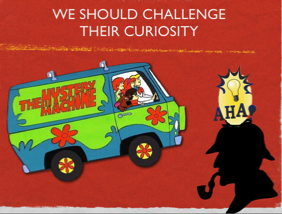
"Solvable mysteries" are central to all natural learning processes.

"Performances" of Understanding are essential for good assessment.

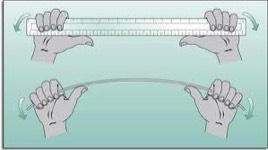

Don't break under stress! Stay flexible!
